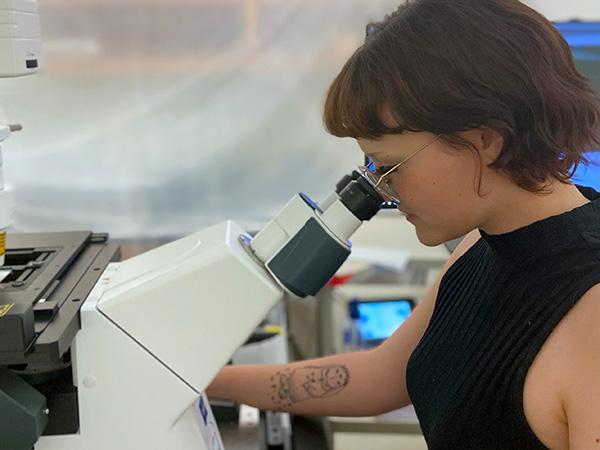Student Project Profile
Ketamine’s Role in Time Perception – Sarah
Project Title
Investigating the Role of (S)-Ketamine in Time Perception
Faculty Mentor(s)
Project Description

Ketamine's ability to disturb time perception in healthy individuals is well-established. Nevertheless, there remains a lack of comprehensive understanding regarding the specific mechanisms by which ketamine alters time perception, and whether these effects vary between females and males. To address this knowledge gap, we are currently delving into the behavioral and neuronal aspects of time perception in mice, aiming to elucidate how ketamine may disrupt this process.
(S)-ketamine, a drug known for its antidepressant properties, is currently utilized in treating treatment-resistant depression. In this project, our primary aim was to explore how (S)-ketamine influences time perception through a mouse model. To achieve this, we assessed behaviors related to time interval estimation in female and male mice using the Serial Fixed Interval task. Additionally, we conducted gene expression assays in brain regions associated with timing to investigate the modulatory effects of ketamine on brain activity. Our findings indicate that ketamine has an impact on timed behaviors, and we expect to observe alterations in brain gene expression due to the administration of (S)-ketamine.
Why is your research important?
Comprehending ketamine’s mechanism of action is vital for comprehending its role in addressing treatment-resistant depression. This research holds significance as it explores potential sex differences concerning (S)-ketamine, an area that has received limited attention in existing studies. By examining potential sex differences, we are advocating for the importance of understanding sex-specific treatment in medicine.
In what ways have you showcased your research thus far?
I have presented at the Midwest Great Lakes Undergraduate Research Symposium, the Oberlin Undergraduate Summer Research Symposium, and the Oberlin Undergraduate Research Symposium. Additionally, I am a coauthor on the paper, “Defective Mitochondrial Dynamics and Protein Degradation Pathways Underlie Cadmium-Induced Neurotoxicity and Cell Death in Huntington’s Disease Striatal Cells”, as well as another paper that is still under review.
What is your favorite aspect of the research process?
The part of research I enjoy the most is the process of planning out experiments. I find it fascinating to establish connections between the results of one experiment and the subsequent experiment's design. What makes this project particularly special to me is its significant societal importance and the potential impact it can have.
How has working with your mentor impacted the development of your research project? How has it impacted you as a researcher?
I am incredibly grateful to conduct research under mentorship where I feel supported and my ideas as a scientist are encouraged. There is such a welcoming and accepting environment in the lab which makes me feel excited to conduct research.
How has the research you’ve conducted contributed to your professional or academic development?
Due to initiating my research endeavors at an early stage, I have been able to apply the practical skills I acquired to grasp the concepts taught in my current and future academic courses. Moreover, engaging in research has significantly contributed to my professional growth, helping me discern my true passions and shaping the trajectory of my desired career path.
What advice would you give to a younger student wanting to get involved in research in your field?
Though it may seem difficult to get into, conducting research is truly remarkable. Unearthing something novel justifies all the invested time and effort. Not only does it enhance your academic knowledge, but it also serves as a developmental process to determine whether research aligns with your future aspirations.
This is a joint project with Sophia Krikawa.
Students

Sarah McDonald ’25
third-year- Major(s):
- Neuroscience, Religion